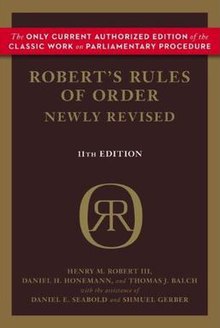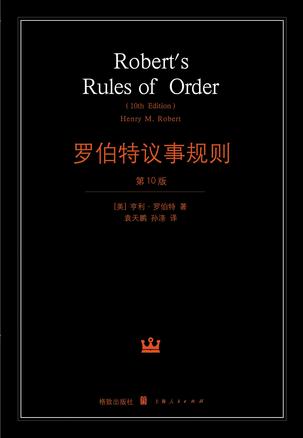Note: @唐鸿寿 at WeChat:
罗伯特议事规则5,如下:
5.文明表达原则
(1)禁止人身攻击
例:你是猪吗/怎么都不要脸
人身攻击容易导致讨论变成吵架
(2)不得质疑他人动机,习惯或偏好
例:你一定是受谁谁指使………
你肯定收了别人的好处才替他说话……
因为关于动机:
①动机不可证
②审议动机是对议题的偏离,只讨论事不议论人
③利己是人的本性,指责他人动机无意义
(3)要就事论事,以当前待解决问题为限
例:上次也这样......做事总是.......
你用日货就是汉奸……
你反对中医就是不爱国……
在中国大陆的城市人群中,知道罗伯特议事规则的人数很少,只有7%。而即使知道罗伯特议事规则的受访者,也往往只是停留在“听说过”的层面,尚未深入了解。
**
罗伯特议事规则
https://book.douban.com/subject/2382433/
作者: [美] 亨利·罗伯特
出版社: 世纪出版集团 格致出版社
副标题: 第10版(2000年最新版) 中文全译本Robert's Rules of Order Newly Revised, 10th Edition, Perseus Publishing, 2000
译者: 孙涤 / 袁天鹏
出版年: 2008年1月
页数: 650
定价: 48.00元
ISBN: 9787543213906
出版社: 世纪出版集团 格致出版社
副标题: 第10版(2000年最新版) 中文全译本Robert's Rules of Order Newly Revised, 10th Edition, Perseus Publishing, 2000
译者: 孙涤 / 袁天鹏
出版年: 2008年1月
页数: 650
定价: 48.00元
ISBN: 9787543213906
**
罗伯特议事规则
(美国国会开会规则)
编辑 锁定- 书 名
- 罗伯特议事规则
- 作 者
- 亨利·马丁·罗伯特
- 出版时间
- 1876年
- 英文名
- Robert's Rules of Order
罗伯特议事规则内容介绍
编辑罗伯特议事规则具体规则
编辑罗伯特议事规则具体原则
罗伯特议事规则根本原则
罗伯特议事规则六部曲
罗伯特议事规则中国影响
编辑
*********
Robert's Rules of Order
 Cover of 2011 (11th) edition | |
| Author |
|
|---|---|
| Publisher | Da Capo Press, A Member of the Perseus Books Group |
| Publication date | 2011 |
| Pages | 669 (main text), 716 (numbered), 816 (total) |
| ISBN | 978-0-306-82021-2 (hardcover) 978-0-306-82020-5 (paperback) 978-0-306-82022-9 (leatherbound) |
| OCLC | 860989594 |
| 060.42 ROB | |
| LC Class | JF515 .R692 2011 |
Robert's Rules of Order Newly Revised, commonly referred to as Robert’s Rules of Order (or simply Robert’s Rules), is the most widely used manual of parliamentary procedure in the United States.[1] It governs the meetings of a diverse range of organizations—including church groups, county commissions, homeowners associations, nonprofit associations, professional societies, school boards, and trade unions—that have adopted it as their parliamentary authority.[2]
The manual was first published in 1876 by U.S. Army officer Henry Martyn Robert, who adapted the rules and practice of Congress to the needs of non-legislative societies. Ten subsequent editions have been published, including major revisions in 1915 and 1970. The copyright to Robert's Rules of Order Newly Revised is owned by the Robert's Rules Association, which selects by contract an authorship team to continue the task of revising and updating the book. The 11th and current edition was published in 2011.
In 2005, the Robert's Rules Association published an official concise guide, titled Robert's Rules of Order Newly Revised In Brief. A second edition of the brief book was published in 2011.
Contents
[hide]- 1 History and origins
- 2 Official editions and other versions
- 3 Explanation of purpose of book
- 4 Contents of current (11th) edition
- 5 Additional information related to current edition
- 6 Changes between editions
- 7 Explanations of rules in book
- 8 Application to specific organizations
- 9 Alternative rules for organizations
- 10 References
- 11 External links
History and origins[edit]
The first edition of the book, whose full title was Pocket Manual of Rules of Order for Deliberative Assemblies, was published in February 1876 by then U.S. Army Major Henry Martyn Robert (1837–1923) with the short title Robert's Rules of Order placed on its cover.
The procedures prescribed by the book were loosely modeled after those used in the United States House of Representatives, with such adaptations as Robert saw fit for use in ordinary societies.[3] Although he was in the military, the rules in his book were not based on military rules. The author's interest in parliamentary procedure began in 1863 when he was chosen to preside over a church meeting and, although he accepted the task, he felt that he did not have the necessary knowledge of proper procedure.[4]
In his later work as an active member of several organizations, Robert discovered that members from different areas of the country had very different views regarding what the proper parliamentary rules were, and these conflicting views hampered the organizations in their work.[5] He eventually became convinced of the need for a new manual on the subject, one which would enable many organizations to adopt the same set of rules.[4]


